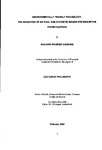ENVIRONMENTALLY FRIENDLY TECHNOLOGY: THE BEHAVIOUR OF NATURAL AND SYNTHETIC BINDER SYSTEMS WITHIN PAPER COATINGS
| dc.contributor.author | LAUDONE, GIULIANO MAURIZIO | |
| dc.contributor.other | Faculty of Science and Engineering | en_US |
| dc.date.accessioned | 2013-10-25T11:05:04Z | |
| dc.date.available | 2013-10-25T11:05:04Z | |
| dc.date.issued | 2005 | |
| dc.identifier | NOT AVAILABLE | en_US |
| dc.identifier.uri | http://hdl.handle.net/10026.1/2377 | |
| dc.description.abstract |
Coating shrinkage upon drying is a phenomenon well known to the paper coating industry, where it often causes changes in the final structure of the coating layer leading to poor results in terms of gloss, light scattering, surface strength, coverage, uniformity and printability. Such shrinkage has in previous studies been wrongly associated with shrinkage of the polymeric binders used in the coating formulation, by making erroneous comparison with solvent-based paint systems. Natural binders, as starch or proteins, which come from renewable resources and are therefore environmentally friendly, suffer more from this shrinkage phenomenon than synthetic binders. The aim of this research project was to improve the understanding of the processes involved in the drying of a coating layer and to create a model able to describe them. Shrinkage while the coating layer dries has been successfully measured by observing the deflection of coated strips of a synthetic elastically-deformable substrate. Ground calcium carbonate was used as the coating pigment, together with latex binders of both low and high glass transition temperature, Tg, respectively, and also with starch which is a natural film-forming water soluble binder. The final dry coatings were studied with mercury porosimetry and by scanning electron microscopy in order to characterise their porous structure. The flow and rheological properties of the coating colour formulations were measured in order to probe the particle-particle interaction between the different species in the wet coating colour. The void space of the dry coating layers was modelled using Pore-Cor, a software which generates simulated porous networks. A new algorithm was developed to model, within the simulated void space, the effective particles or "skeletal elements" representative of the solid phase of the dried porous system. The water-filled porous structures at the beginning of the shrinkage process (first critical concentration, FCC) were subsequently modelled by creating Pore-Cor structures with the same solid skeletal elements distribution as at the second critical concentration (at which the particles lock their positions), but with higher given porosity to account for the water present The capillary forces acting on the surface of the simulated coating were calculated, and found to be several orders of magnitude larger than the measured shrinkage forces. The shrinkage process was thus described as resulting from the effect of capillary forces in the plane of the coating layer resisted by a stick-slip process, where the capillary forces yield shrinkage only if a resistance force within the drying coating layer holds the structure in place and allows the menisci to form. The stick-slip theory was strongly supported by quantitative comparisons between the experimental forces required to intrude mercury, and the capillary forces within the simulated void structure. | en_US |
| dc.description.sponsorship | Omya AG, Oftringen, Switzerland | en_US |
| dc.language.iso | en | en_US |
| dc.publisher | University of Plymouth | en_US |
| dc.title | ENVIRONMENTALLY FRIENDLY TECHNOLOGY: THE BEHAVIOUR OF NATURAL AND SYNTHETIC BINDER SYSTEMS WITHIN PAPER COATINGS | en_US |
| dc.type | Thesis | |
| dc.identifier.doi | http://dx.doi.org/10.24382/3625 |
Files in this item
This item appears in the following Collection(s)
-
01 Research Theses Main Collection
Research Theses Main


